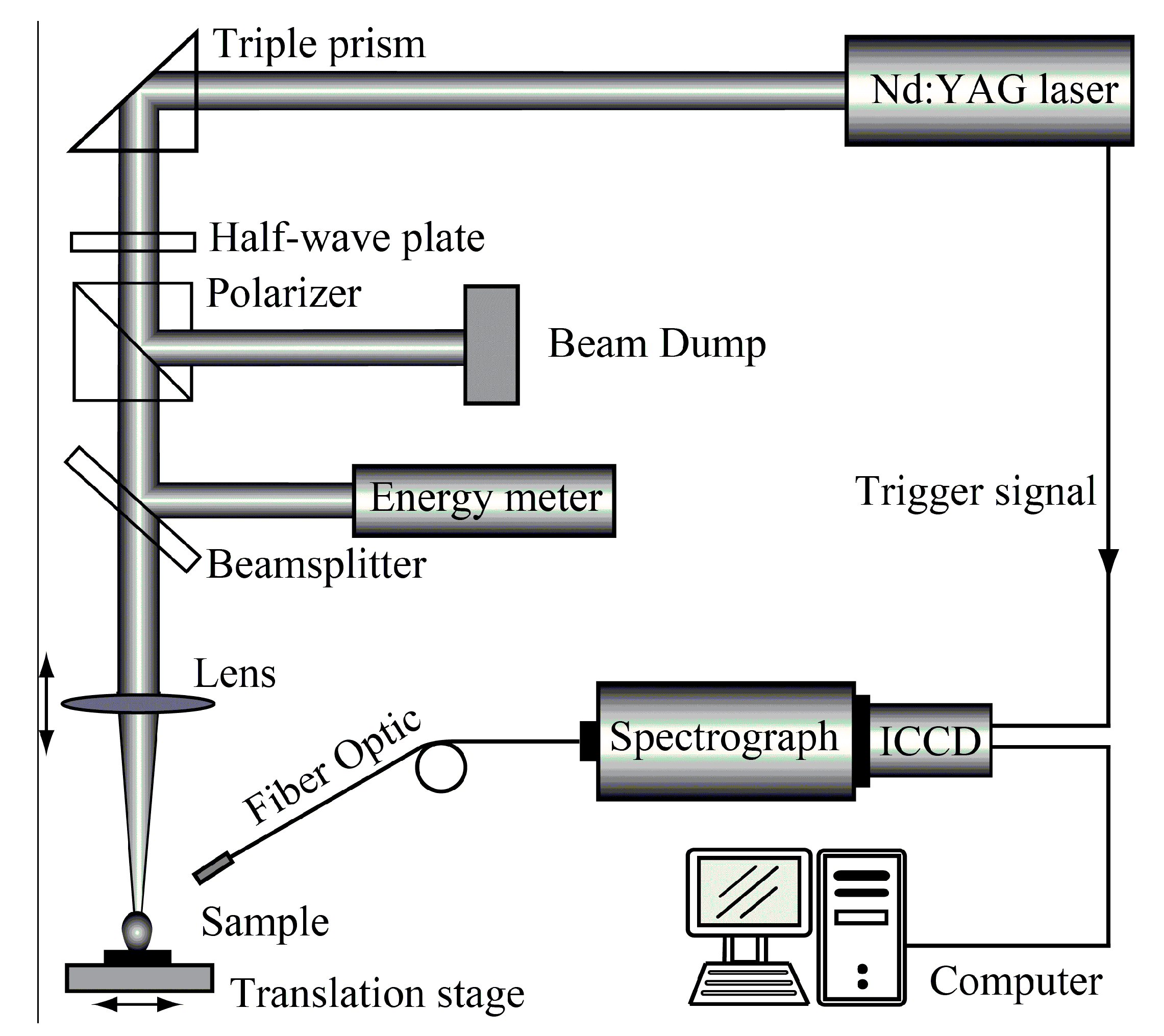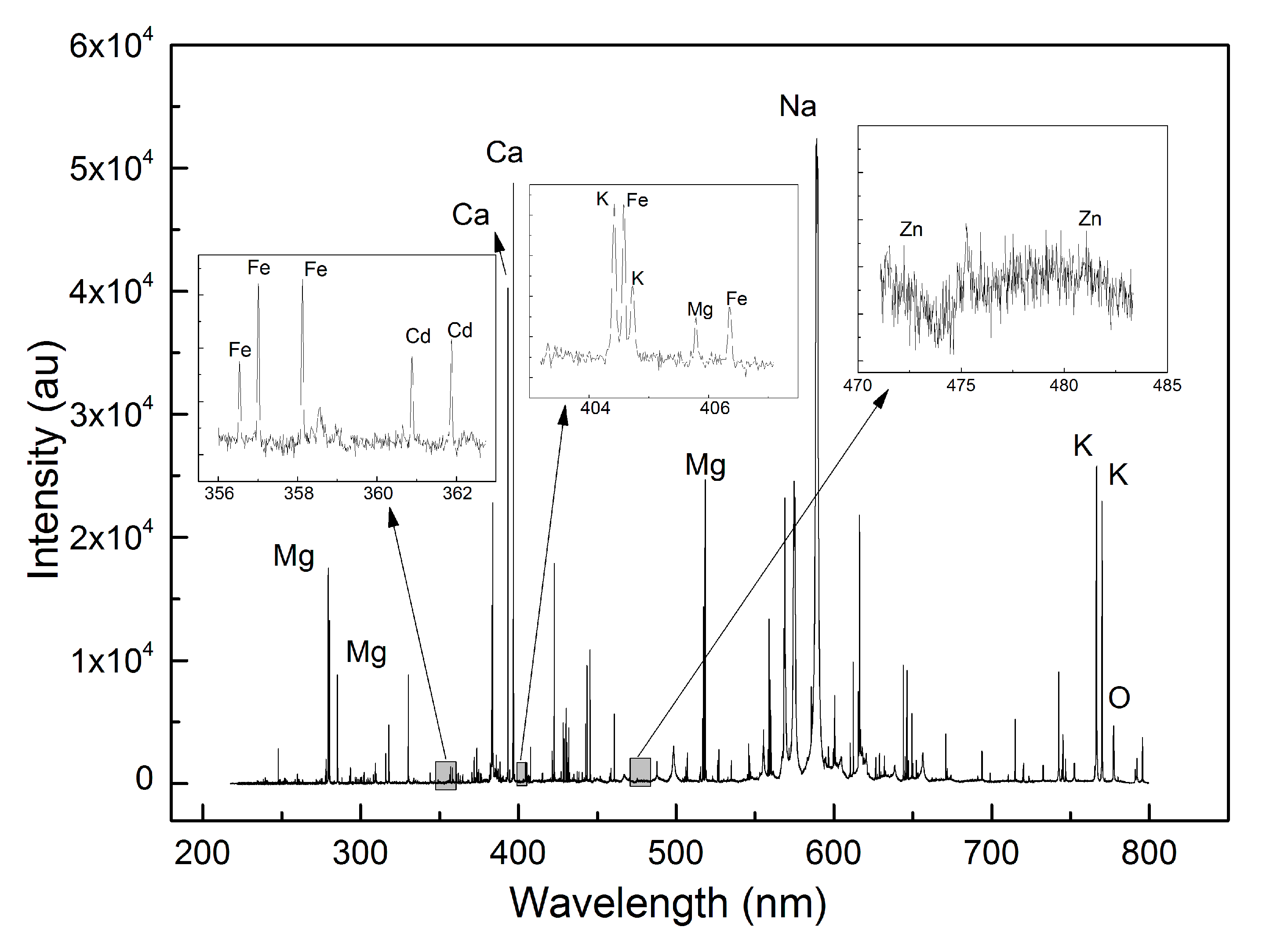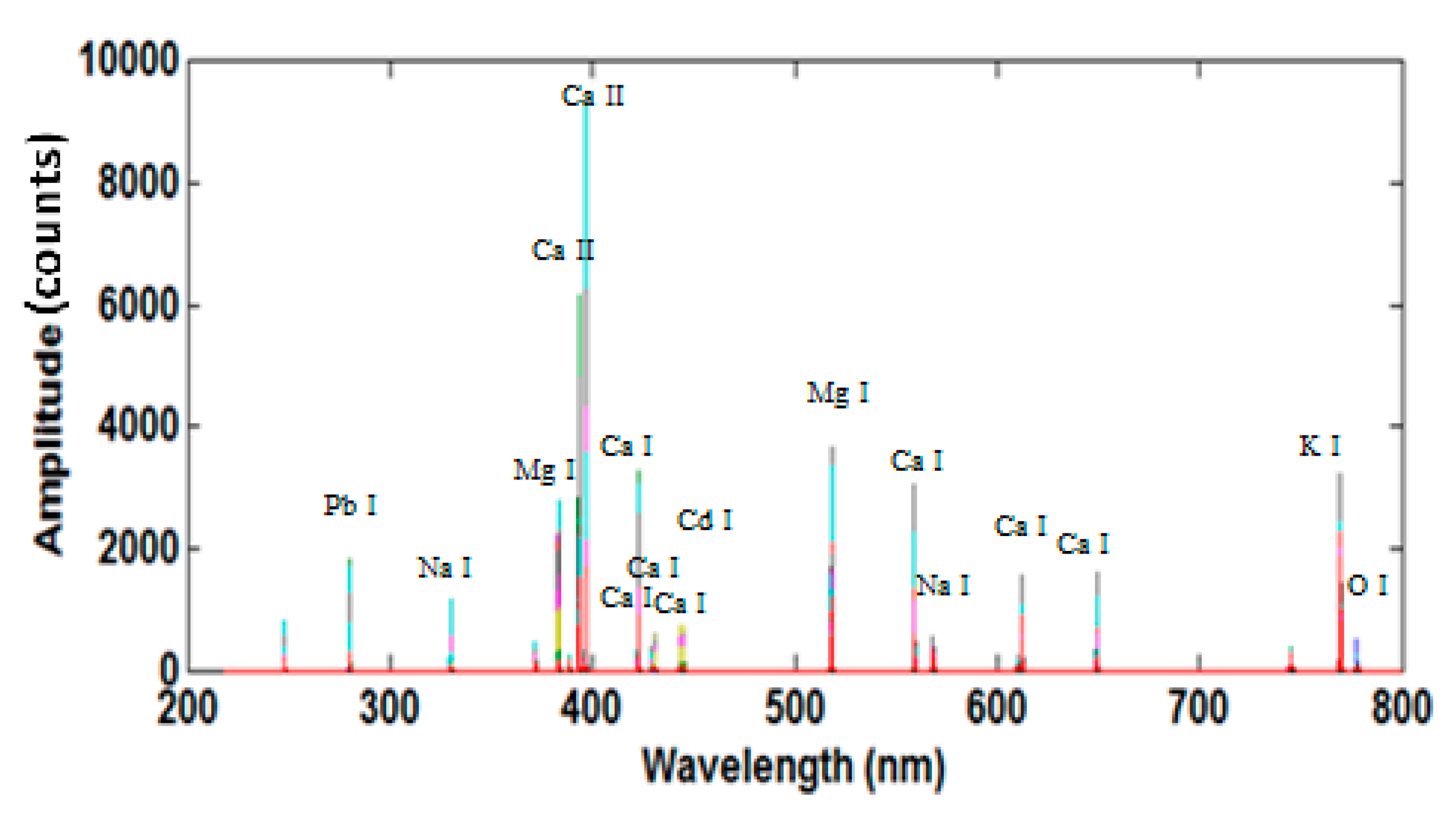Laser-Induced Breakdown Spectroscopy for Rapid Discrimination of Heavy-Metal-Contaminated Seafood Tegillarca granosa
Abstract
:1. Introduction
2. Materials and Methods
2.1. Sample Preparation
2.2. Spectral Collection
2.3. Wavelet Transform Algorithm
2.4. Information Gain Algorithm
2.5. Spectral Calibration and Analysis Methods
3. Results and Discussion
3.1. Analysis of LIBS Spectra
3.2. Analysis of Discrimination Results Using Full Spectra
3.3. Analysis of Results Using Characteristic Spectra
3.4. Analysis of Reconstructed Spectra
4. Conclusions
Acknowledgments
Author Contributions
Conflicts of Interest
References
- Barron, M.G.; Stehly, G.R.; Hayton, W.L. Pharmacokinetic modeling in aquatic animals I. Models and concepts. Aquat. Toxicol. 1990, 17, 187–212. [Google Scholar] [CrossRef]
- Chen, X.; Liu, K.; Cai, J.; Zhu, D.; Chen, H. Identification of heavy metal-contaminated Tegillarca granosa using infrared spectroscopy. Anal. Methods 2015, 7, 2172–2181. [Google Scholar] [CrossRef]
- Wen, Y.M.; Gao, R.C. Nutritive and Officinal Value of Tegillarca granosa. J. Econ. Anim. 2009, 13, 168–182. [Google Scholar]
- Bao, Y.; Li, P.; Dong, Y.; Xiang, R.; Gu, L.; Yao, H.; Wang, Q.; Lin, Z. Polymorphism of the multiple hemoglobins in blood clam Tegillarca granosa and its association with disease resistance to Vibrio parahaemolyticus. Fish Shellfish Immunol. 2013, 34, 1320–1324. [Google Scholar] [CrossRef] [PubMed]
- Hare, L. Aquatic insects and trace metals: Bioavailability, bioaccumulation, and toxicity. Crit. Rev. Toxicol. 1992, 22, 327–369. [Google Scholar] [CrossRef] [PubMed]
- Fung, C.N.; Lam, J.C.; Zheng, G.J.; Connell, D.W.; Monirith, I.; Tanabe, S.; Richardson, B.J.; Lam, P.K. Mussel-based monitoring of trace metal and organic contaminants along the east coast of China using Perna viridis and Mytilus edulis. Environ. Pollut. 2004, 127, 203–216. [Google Scholar] [CrossRef] [PubMed]
- Pestana, J.L.; Ré, A.; Nogueira, A.J.; Soares, A.M. Effects of Cadmium and Zinc on the feeding behaviour of two freshwater crustaceans: Atyaephyra desmarestii (Decapoda) and Echinogammarus meridionalis (Amphipoda). Chemosphere 2007, 68, 1556–1562. [Google Scholar] [CrossRef] [PubMed]
- Behbahani, M.; Tapeh, N.A.; Mahyari, M.; Pourali, A.R.; Amin, B.G.; Shaabani, A. Monitoring of trace amounts of heavy metals in different food and water samples by flame atomic absorption spectrophotometer after preconcentration by amine-functionalized graphene nanosheet. Environ. Monit. Assess. 2014, 186, 7245–7257. [Google Scholar] [CrossRef] [PubMed]
- Tormen, L.; Torres, D.P.; Dittert, I.M.; Araújo, R.G.O.; Frescura, V.L.A.; Curtius, A.J. Rapid assessment of metal contamination in commercial fruit juices by inductively coupled mass spectrometry after a simple dilution. J. Food Compos. Anal. 2011, 24, 95–102. [Google Scholar]
- Tuzen, M. Determination of heavy metals in fish samples of the middle Black Sea (Turkey) by graphite furnace atomic absorption spectrometry. Food Chem. 2003, 80, 119–123. [Google Scholar] [CrossRef]
- Aragay, G.; Merkoçi, A. Nanomaterials application in electrochemical detection of heavy metals. Electrochim. Acta 2012, 84, 49–61. [Google Scholar] [CrossRef]
- Li, N.; Zhang, D.; Zhang, Q.; Lu, Y.; Jiang, J.; Liu, G.; Liu, Q. Combining localized surface plasmon resonance with anodic stripping voltammetry for heavy metal ion detection. Sens. Actuators B Chem. 2016, 231, 349–356. [Google Scholar] [CrossRef]
- Ghica, M.E.; Carvalho, R.C.; Amine, A.; Brett, C.M.A. Glucose oxidase enzyme inhibition sensors for heavy metals at carbon film electrodes modified with cobalt or copper hexacyanoferrate. Sens. Actuators B Chem. 2013, 178, 270–278. [Google Scholar] [CrossRef]
- Gao, W.; Nan, T.; Tan, G.; Zhao, H.; Wang, B.; Li, Q.X.; Meng, F. Development of a sensitive monoclonal antibody-based enzyme-linked immunosorbent assay for the analysis of cadmium ions in water, soil and rape samples. Food Agric. Immunol. 2011, 23, 27–39. [Google Scholar] [CrossRef]
- Chen, X.; Wu, D.; Guan, X.; Liu, B.; Liu, G.; Yan, M.; Chen, H. Feasibility of Infrared and Raman Spectroscopies for Identification of Juvenile Black Seabream (Sparus macrocephalus) Intoxicated by Heavy Metals. J. Agric. Food Chem. 2013, 61, 12429–12435. [Google Scholar] [CrossRef] [PubMed]
- Palaniappan, P.R.; Vijayasundaram, V. Fourier transform infrared study of protein secondary structural changes in the muscle of Labeo rohita due to arsenic intoxication. Food Chem. Toxicol. 2008, 46, 3534–3539. [Google Scholar] [CrossRef] [PubMed]
- Palaniappan, P.R.; Pramod, K.S.; Vijayasundaram, V. Effect of acute concentration of zinc on the biochemical contents of brain of Labeo rohita: An FT-IR study. Environ. Chem. Lett. 2009, 7, 313–319. [Google Scholar] [CrossRef]
- Pathak, A.K.; Kumar, R.; Singh, V.K.; Agrawal, R.; Rai, S.; Rai, A.K. Assessment of LIBS for Spectrochemical Analysis: A review. Appl. Spectrosc. Rev. 2012, 47, 14–40. [Google Scholar] [CrossRef]
- Wang, Z.; Feng, J.; Li, L.; Ni, W.; Li, Z. A multivariate model based on dominant factor for laser-induced breakdown spectroscopy measurements. J. Anal. At. Spectrom. 2011, 26, 2289–2299. [Google Scholar] [CrossRef]
- Sturm, V.; Schmitz, H.U.; Reuter, T.; Fleige, R.; Noll, R. Fast vacuum slag analysis in a steel works by laser-induced breakdown spectroscopy. Spectrochim. Acta Part B Atom. Spectrosc. 2008, 63, 1167–1170. [Google Scholar] [CrossRef]
- Zhu, D.; Cao, Y.; Zhong, R.; Chen, X. Quantitative Analysis of Composition Change in AZ31 Magnesium Alloy Using CF-LIBS After Laser Material Processing. Plasma Sci. Technol. 2015, 17, 909–913. [Google Scholar] [CrossRef]
- Burakov, V.S.; Tarasenko, N.V.; Nedelko, M.I.; Kononov, V.A.; Vasilev, N.N.; Isakov, S.N. Analysis of lead and sulfur in environmental samples by double pulse laser induced breakdown spectroscopy. Spectrochim. Acta Part B Atom. Spectrosc. 2009, 64, 141–146. [Google Scholar] [CrossRef]
- Fortes, F.J.; Ctvrtnickova, T.; Mateo, M.P.; Cabalin, L.M.; Nicolas, G.; Laserna, J.J. Spectrochemical study for the in situ detection of oil spill residues using laser-induced breakdown spectroscopy. Anal. Chim. Acta 2010, 683, 52–57. [Google Scholar] [CrossRef] [PubMed]
- Zhu, D.; Chen, J.; Lu, J.; Ni, X. Laser-induced breakdown spectroscopy for determination of trace metals in aqueous solution using bamboo charcoal as a solid-phase extraction adsorbent. Anal. Methods 2012, 4, 819–823. [Google Scholar] [CrossRef]
- Bilge, G.; Velioglu, H.M.; Sezer, B.; Eseller, K.E.; Boyaci, I.H. Identification of meat species by using laser-induced breakdown spectroscopy. Meat Sci. 2016, 119, 118–122. [Google Scholar] [CrossRef] [PubMed]
- Manzoor, S.; Rosales, J.D.; Anzano, J.; Caceres, J.O. Qualitative and quantitative analysis of milk for the detection of adulteration by Laser Induced Breakdown Spectroscopy (LIBS). Food Chem. 2017, 232, 322–328. [Google Scholar]
- Anglos, D.; Georgiou, S.; Fotakis, C. Lasers in the Analysis of Cultural Heritage Materials. J. Nano Res. 2009, 8, 47–60. [Google Scholar] [CrossRef]
- Svanberg, S. Laser based diagnostics—From cultural heritage to human health. Appl. Phys. B-Lasers Opt. 2008, 92, 351–358. [Google Scholar] [CrossRef]
- Rehse, S.J.; Salimnia, H.; Miziolek, A.W. Laser-induced breakdown spectroscopy (LIBS): an overview of recent progress and future potential for biomedical applications. J. Med. Eng. Technol. 2012, 36, 77–89. [Google Scholar] [CrossRef] [PubMed]
- Motto-Ros, V.; Sancey, L.; Wang, X.C.; Ma, Q.L.; Lux, F.; Bai, X.S.; Panczer, G.; Tillement, O.; Yu, J. Mapping nanoparticles injected into a biological tissue using laser-induced breakdown spectroscopy. Spectrochim. Acta Part B-Atom. Spectrosc. 2013, 87, 168–174. [Google Scholar] [CrossRef]
- Riedo, A.; Bieler, A.; Neuland, M.; Tulej, M.; Wurz, P. Performance evaluation of a miniature laser ablation time-of-flight mass spectrometer designed for in situ investigations in planetary space research. J. Mass Spectrom. 2013, 48, 1–15. [Google Scholar] [CrossRef] [PubMed]
- Knight, A.K.; Scherbarth, N.L.; Cremers, D.A.; Ferris, M.J. Characterization of Laser-Induced Breakdown Spectroscopy (LIBS) for Application to Space Exploration. Appl. Spectrosc. 2000, 54, 331–340. [Google Scholar] [CrossRef]
- Daubechies, I. The wavelet transform, time-frequency localization and signal analysis. IEEE Trans. Inf. Theory 1990, 36, 961–1005. [Google Scholar] [CrossRef]
- Singh, R.; Khare, A. Fusion of multimodal medical images using Daubechies complex wavelet transform—A multiresolution approach. Inf. Fusion 2012, 19, 49–60. [Google Scholar] [CrossRef]
- Demirel, H.; Anbarjafari, G. IMAGE Resolution Enhancement by Using Discrete and Stationary Wavelet Decomposition. IEEE Trans. Image Process. 2011, 20, 1458–1460. [Google Scholar] [CrossRef] [PubMed]
- Dai, J.; Xu, Q. Attribute selection based on information gain ratio in fuzzy rough set theory with application to tumor classification. Appl. Soft Comput. 2013, 13, 211–221. [Google Scholar] [CrossRef]
- Pérezenciso, M.; Tenenhaus, M. Prediction of clinical outcome with microarray data: A partial least squares discriminant analysis (PLS-DA) approach. Hum. Genet. 2003, 112, 581–592. [Google Scholar]
- Uğuz, H. A two-stage feature selection method for text categorization by using information gain, principal component analysis and genetic algorithm. Knowl.-Based Syst. 2011, 24, 1024–1032. [Google Scholar] [CrossRef]
- Yuan, L.-M.; Sun, L.; Lin, H.; Han, E.; Liu, H.-L.; Cai, J.-R. Nondestructive Measurement of Soluble Solids Content in Apples by a Portable Fruit Analyzer. Spectrosc. Spect. Anal. 2013, 33, 2387–2391. [Google Scholar] [CrossRef]
- Breiman, L. Characterization of asian and north American avian H5N1. Mach. Learn. 2001, 45, 5–32. [Google Scholar] [CrossRef]
- Wu, D.; Feng, L.; Zhang, C.; He, Y. Early Detection of Botrytis cinerea on Eggplant Leaves Based on Visible and Near-Infrared Spectroscopy. Trans. ASABE 2008, 51, 1133–1139. [Google Scholar] [CrossRef]
- Díaz-Uriarte, R.; De Andres, S.A. Gene selection and classification of microarray data using random forest. BMC Bioinform. 2006, 7, 3. [Google Scholar] [CrossRef] [PubMed]
- Van Gestel, T.; Suykens, J.A.K.; Baesens, B.; Viaene, S.; Vanthienen, J.; Dedene, G.; De Moor, B.; Vandewalle, J. Least Squares Support Vector Machine Classifiers. Neural Process. Lett. 1999, 9, 293–300. [Google Scholar] [CrossRef]
- Suykens, J.A.K.; Van Gestel, T.; De Brabanter, J.; De Moor, B.; Vandewalle, J. Least Squares Support Vector Machines; World Scientific Publishing Co. Pte. Ltd.: Singapore, 2002; Chapter 71–116. [Google Scholar]
- Jihan, C.; Yonglin, L.; Peng, C.; Kai, L.; Qiyu, S.; Xiangyong, Z. Preliminary study on zeolite materials used to control of heavy metal pollution during the culture of mud clam Tegillarca granosa L. Aquac. Res. 2015, 46, 1426–1435. [Google Scholar] [CrossRef]
- Bao, Y.; Xiao, L.; Zhang, W.; Cao, J.; Wei, L.; Li, C. Identification of a regulation network in response to cadmium toxicity using blood clam Tegillarca granosa as model. Sci. Rep. 2016, 6, 35704. [Google Scholar] [CrossRef] [PubMed]
- Liu, G.X.; Chai, X.L.; Shao, Y.Q.; Wu, H.X. Histopathological Alternations of Blood Clam Tegillarca granosa in Acute Copper, Zinc, Lead and Cadmium Exposures. Adv. Mater. Res. 2012, 518–523, 422–425. [Google Scholar] [CrossRef]





| Spectral Emission Lines (nm) | Elements |
|---|---|
| 280.2 | Pb I |
| 330.1 | Na I |
| 383.5 | Mg I |
| 393.4 | Ca II |
| 396.8 | Ca II |
| 428.7 | Ca I |
| 430.8 | Ca I |
| 443.4 | Ca I |
| 445.3 | Ca I |
| 467.8 | Cd I |
| 518.3 | Mg I |
| 558.9 | Ca I |
| 568.4 | Na I |
| 612.1 | Ca I |
| 649.4 | Ca I |
| 769.5 | K I |
| 777.5 | O I |
© 2017 by the authors. Licensee MDPI, Basel, Switzerland. This article is an open access article distributed under the terms and conditions of the Creative Commons Attribution (CC BY) license (http://creativecommons.org/licenses/by/4.0/).
Share and Cite
Ji, G.; Ye, P.; Shi, Y.; Yuan, L.; Chen, X.; Yuan, M.; Zhu, D.; Chen, X.; Hu, X.; Jiang, J. Laser-Induced Breakdown Spectroscopy for Rapid Discrimination of Heavy-Metal-Contaminated Seafood Tegillarca granosa. Sensors 2017, 17, 2655. https://doi.org/10.3390/s17112655
Ji G, Ye P, Shi Y, Yuan L, Chen X, Yuan M, Zhu D, Chen X, Hu X, Jiang J. Laser-Induced Breakdown Spectroscopy for Rapid Discrimination of Heavy-Metal-Contaminated Seafood Tegillarca granosa. Sensors. 2017; 17(11):2655. https://doi.org/10.3390/s17112655
Chicago/Turabian StyleJi, Guoli, Pengchao Ye, Yijian Shi, Leiming Yuan, Xiaojing Chen, Mingshun Yuan, Dehua Zhu, Xi Chen, Xinyu Hu, and Jing Jiang. 2017. "Laser-Induced Breakdown Spectroscopy for Rapid Discrimination of Heavy-Metal-Contaminated Seafood Tegillarca granosa" Sensors 17, no. 11: 2655. https://doi.org/10.3390/s17112655





